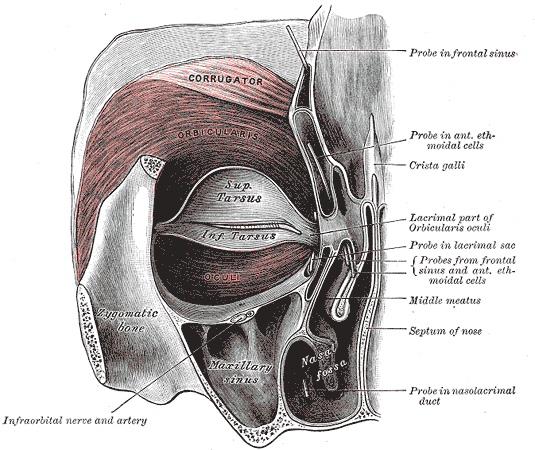Blepharospasm
For patient information page on this topic click here
| Blepharospasm | |
 | |
|---|---|
| Left orbicularis oculi, seen from behind. |
|
WikiDoc Resources for Blepharospasm |
|
Articles |
|---|
|
Most recent articles on Blepharospasm Most cited articles on Blepharospasm |
|
Media |
|
Powerpoint slides on Blepharospasm |
|
Evidence Based Medicine |
|
Clinical Trials |
|
Ongoing Trials on Blepharospasm at Clinical Trials.gov Trial results on Blepharospasm Clinical Trials on Blepharospasm at Google
|
|
Guidelines / Policies / Govt |
|
US National Guidelines Clearinghouse on Blepharospasm NICE Guidance on Blepharospasm
|
|
Books |
|
News |
|
Commentary |
|
Definitions |
|
Patient Resources / Community |
|
Patient resources on Blepharospasm Discussion groups on Blepharospasm Patient Handouts on Blepharospasm Directions to Hospitals Treating Blepharospasm Risk calculators and risk factors for Blepharospasm
|
|
Healthcare Provider Resources |
|
Causes & Risk Factors for Blepharospasm |
|
Continuing Medical Education (CME) |
|
International |
|
|
|
Business |
|
Experimental / Informatics |
Editor-In-Chief: C. Michael Gibson, M.S., M.D. [1]
Synonyms and keywords: Eyelid twitch
Overview
A blepharospasm ('eye twitching') is any abnormal tic or twitch of the eyelid (from blepharo, eyelid, and spasm, an uncontrolled muscle contraction). However, it is normally distinguished from less serious disorders and refers to Benign Essential Blepharospasm, a focal dystonia (a neurological movement disorder involving involuntary and sustained muscle contractions) of the muscles around the eyes. The cause is often undetermined, but fatigue or a an irritant are possible contributing factors. Symptoms usually last for a few days then disappear without treatment, but in some cases the twitching is chronic and persistent. Occasionally, the symptoms are severe enough to result in effective blindness.
Causes
In most cases, blepharospasm seems to develop spontaneously. Many blepharospasm patients have a previous history of dry eyes and/or light sensitivity. Blepharospasm can also come from abnormal functioning of the brain's basal ganglia. Concomitance with dry eye, as well as other dystonias such as Meige's syndrome, has been observed. Some drugs can induce blepharospasm, such as Dimercaprol, those used to treat Parkinson's disease, as well as sensitivity to hormone treatments, including estrogen replacement therapy for women going through menopause. Blepharospasms can be caused by concussions in some rare cases, when a blow to the back of the head damages the basal ganglia.
Diagnosis
History and Symptoms
- Uncontrollable tics or twitches of the eye muscles and surrounding facial area
- Excessive blinking of the eyes, or forced closure of durations longer than the typical blink reflex
- Dryness of the eyes
- Sensitivity to the sun and bright light
Treatment
Medical Therapy
- Drug therapy for blepharospasm has proved generally unpredictable and short-termed. Finding an effective regimen for any patient usually requires trial and error over time. In some cases a dietary supplement of magnesium chloride has been found effective.
- Botulin toxin injections have been used to induce localized partial paralysis.
Non-Pharmacotherapy
- Dark glasses are often worn because of sunlight sensitivity, as well as to hide the eyes from others.
- Stress management and support groups can help sufferers deal with the disease and prevent social isolation.
- Using tweezers to remove excess eyelashes from the outer corner of the eyelid may sometimes resolve this condition.
Surgery
Patients that do not respond well to medication or botulinum toxin injection are candidates for surgical therapy. The most effective surgical treatment has been protractor myectomy, the removal of muscles responsible for eyelid closure.
References
External Links
- Blepharospasm Resource Guide from the National Eye Institute (NEI).